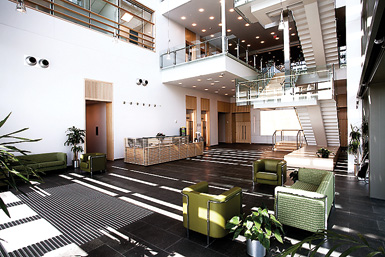In Focus: Measure By Measure, Green and Productivity Goals Become Aligned
Does going green mean your workforce becomes more productive? Sometimes — but not all green workplaces are created equal.
Q4 2014
Unearthing the hard evidence that a company’s sustainability programs are — or are not — enhancing productivity requires meaningful metrics that quantify both sustainability tactics and productivity impacts. Of course, many organizations already compile some sustainability and employee productivity data — but comparing these data sets to inform holistic strategies for specific facilities is an emerging concept. In fact, addressing this challenge is the focus of a new research report by the World Green Building Council titled “Health, Wellbeing & Productivity in Offices: the Next Chapter for Green Building.”
Sustainability goals on their own certainly have significant bearing on a company’s bottom line. But the potential value of green workplace programs increases dramatically when it is strategically aligned with workplace productivity goals.
Side-by-Side Comparisons Drive Organizational Value
Sustainability goals on their own certainly have significant bearing on a company’s bottom line. But the potential value of green workplace programs increases dramatically when it is strategically aligned with workplace productivity goals. For example, consider the “3:30:300” rule of thumb. If an organization spends $3 per square foot on annual utilities, $30 on rent, and $300 on payroll, a 2 percent improvement in energy efficiency results in savings of $0.06 per square foot — while a 2 percent improvement in productivity increases value by $6 per square foot. Implementing tactics that support both sides of equation will bring even greater benefit than those developed in isolation.
The key is to use a metrics system that enables easy comparison of green and productive tactics within all applicable categories, such as energy, waste, and water use; space efficiency; and employee wellness and productivity. Evaluating dual line-item impacts in these categories exposes areas for improvement. For example, a facility achieving energy savings may achieve a high “green” score, but a low score in productivity because employees are too hot or cold. The right metrics will enable a company to quantify the impact on annual revenue. Using metrics will also allow managers to quantify the impact of program successes. For example, an office could be right-sized to achieve energy savings by eliminating underutilized space, while being thoughtfully reconfigured to improve productivity with workspaces that better accommodate the work performed within them. Both the energy savings and the productivity improvement can be measured to create a balanced view of the office redesign.
Ultimately, the use of a wide range of metrics and related analyses will provide insights far beyond stating the face value of any single initiative. Enormous potential lies in analyzing data across these traditionally separate realms of sustainability and productivity. Side-by-side impact comparisons can support long-term strategic thinking that strengthens both sustainability and productivity efforts. It’s all in the integrated numbers.
Project Announcements
Eurofins Lancaster Laboratories Expands Lancaster County, Research Operations
01/03/2026
Valerie Health Plans Chattanooga, Tennessee, Operations
01/02/2026
Samsung Biologics Plans Rockville, Maryland, Manufacturing Operations
12/31/2025
SencorpWhite Plans Hamilton, Ohio, Headquarters-Manufacturing Operations
12/29/2025
Kraken Technologies Limited Plans New York City Headquarters Operations
12/29/2025
Lupin Expands Coral Springs, Florida, Operations
12/29/2025
Most Read
-
The Workforce Bottleneck in America’s Manufacturing Revival
Q4 2025
-
Rethinking Local Governments Through Consolidation and Choice
Q3 2025
-
Data Centers in 2025: When Power Became the Gatekeeper
Q4 2025
-
Lead with Facts, Land the Deal
Q3 2025
-
Tariff Shockwaves Hit the Industrial Sector
Q4 2025
-
Investors Seek Shelter in Food-Focused Real Estate
Q3 2025
-
America’s Aerospace Reboot
Q3 2025
